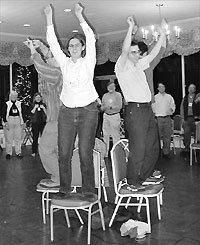|
By Camilla Feibelman
Sierra Student Coalition National Director
 When
I was 15, I started an environmental group at my high school. My first
objective was to begin a recycling program at our school; the second
was to build a worldwide environmental movement. When
I was 15, I started an environmental group at my high school. My first
objective was to begin a recycling program at our school; the second
was to build a worldwide environmental movement.
I learned two lessons. First, we could use our power to get the city and school board to run the program. Second, there was already a world of experienced adult environmental activists who could give us the tools we needed to be effective.
But we weren't sure how to fold ourselves into what they were working on, and no one reached out to us. Now, as national director of the Sierra Student Coalition, I see some of the same missed opportunities. The SSC is an important Club resource.
Though skilled at stamp licking and envelope stuffing, students are anxious to do more than that. Just ask. If you're hosting a press conference, invite a young person to speak. If you're meeting with the mayor, bring a student along. If you're going to file a suit against a company or the local government, advertise for a student intern. And if the students in your area are planning something, ask how you can help.
Not sure what the SSC is up to? Look at our track record in 2000.
Students at more than 90 campuses around the country generated 35,000 of the 1 million comments that came in on President Clinton's wild forest protection plan during the summer public-comment period. They tabled, went door to door in dormitories, discussed the issue in classrooms and held letter-writing parties.
In the fall, SSC hired its first Environmental Voter Education Campaign organizer.
On campuses coast to coast, we used innovative tactics to spread our message. SSC members at Harvard, for example, strung the campus with laundry lines and hung boxer shorts to symbolically put Gov. George W. Bush's dirty environmental laundry out to dry.
The SSC was represented at the fall global warming conference in The Hague when 18 members went and lobbied for a strong agreement. Students also held press conferences on the issue here at home.
And the SSC isn't just working for the sustainability of the planet; we're working for the sustainability of the movement by preparing the next generation of activists.
For instance, more than 100 students from about 36 states got fired up on the issues and were trained in lobbying skills at the second annual SSC Public Lands Action Summit in Washington, D.C. In a single day they made a total of more than 100 visits to senators and representatives to discuss various bills.
The summit prepared students to take the campaigns home with them. The Brown University SSC group lobbied Sen. Lincoln Chaffee (R-R.I.) until his legislative aide called to say he'd co-sponsor the Arctic bill (S.867), and that the group could take responsibility for that fact.
The past summer's Wild Utah! Activist Field Training brought 26 students and 13 leaders to Utah to learn how to run a campus campaign to protect Utah wilderness.
Finally, we again held two annual training programs - the SSC's Student Environmental Training Academy teaches high school and college students and the Summer Environmental Leadership Training Program gives students the skills to develop their own environmental groups on campus, or make an existing one more effective.
As you can see, we're trained, we're inspired, we have creative ideas and we're ready to work. We dare you to tap into this resource.
Invite the Sierra Student Coalition to be involved in a campaign, help them
with theirs, or get more information on spring activities by calling
(888) JOIN-SSC; www.ssc.org.
Photo credit:
Gettin' Goofy: It's fun to be an environmental activist! At
least that's how a group of Club folks felt when they followed a cheer
led by Sierra Student Coalition National Director Camilla Feibelman
and Trainings Director John Kamp.
Up to Top
|